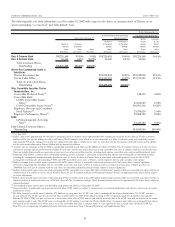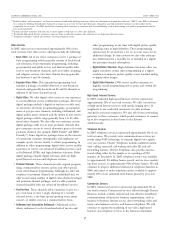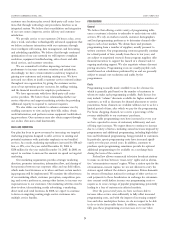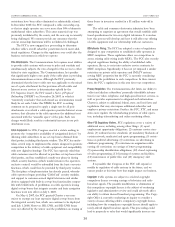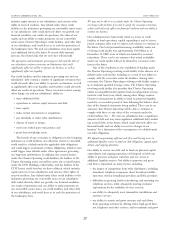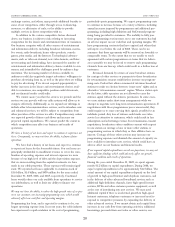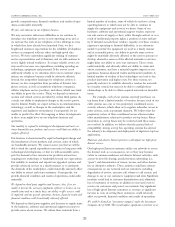Charter 2007 Annual Report Download - page 24
Download and view the complete annual report
Please find page 24 of the 2007 Charter annual report below. You can navigate through the pages in the report by either clicking on the pages listed below, or by using the keyword search tool below to find specific information within the annual report.
VIDEO SERVICE
Cable Rate Regulation. The cable industry has operated under a
federal rate regulation regime for more than a decade. The
regulations currently restrict the prices that cable systems charge
for the minimum level of video programming service, referred to
as “basic service,” and associated equipment. All other cable
offerings are now universally exempt from rate regulation.
Although basic service rate regulation operates pursuant to a
federal formula, local governments, commonly referred to as
local franchising authorities, are primarily responsible for admin-
istering this regulation. The majority of our local franchising
authorities have never been certified to regulate basic service
cable rates (and order rate reductions and refunds), but they
generally retain the right to do so (subject to potential regulatory
limitations under state franchising laws), except in those specific
communities facing “effective competition,” as defined under
federal law. With increased competition from DBS and telephone
companies offering video service, our systems are increasingly
likely to satisfy the effective competition standard. We have
already secured FCC recognition of effective competition, and
become rate deregulated in many of our communities.
There have been frequent calls to impose expanded rate
regulation on the cable industry. Confronted with rapidly increas-
ing cable programming costs, it is possible that Congress may
adopt new constraints on the retail pricing or packaging of cable
programming. For example, there has been considerable legisla-
tive and regulatory interest in requiring cable operators to offer
historically bundled programming services on an à la carte basis,
or to at least offer a separately available child-friendly “family
tier.” Such mandates could adversely affect our operations.
Federal rate regulations generally require cable operators to
allow subscribers to purchase premium or pay-per-view services
without the necessity of subscribing to any tier of service, other
than the basic service tier. The applicability of this rule in certain
situations remains unclear, and adverse decisions by the FCC
could affect our pricing and packaging of services. As we attempt
to respond to a changing marketplace with competitive pricing
practices, such as targeted promotions and discounts, we may
face Communications Act uniform pricing requirements that
impede our ability to compete.
Must Carry/Retransmission Consent. There are two alternative legal
methods for carriage of local broadcast television stations on
cable systems. Federal “must carry” regulations require cable
systems to carry local broadcast television stations upon the
request of the local broadcaster. Alternatively, federal law
includes “retransmission consent” regulations, by which popular
commercial television stations can prohibit cable carriage unless
the cable operator first negotiates for “retransmission consent,”
which may be conditioned on significant payments or other
concessions. Broadcast stations must elect “must carry” or
“retransmission consent” every three years, with the next election
to be made prior to October 1, 2008. Either option has a
potentially adverse effect on our business. Popular stations
invoking “retransmission consent” have been increasingly
demanding in their negotiations with cable operators.
In September 2007, the FCC adopted an order increasing
the cable industry’s existing must-carry obligations by requiring
cable operators to offer “must carry” broadcast signals in both
analog and digital format (dual carriage) for a three year period
commencing on February 17, 2009, the date on which the
broadcast television industry will complete its ongoing transition
from an analog to digital format. The burden could increase
further if cable systems are required to carry multiple program
streams included within a single digital broadcast transmission
(multicast carriage), which the recent FCC order did not address.
Additional government-mandated broadcast carriage obligations
could disrupt existing programming commitments, interfere with
our preferred use of limited channel capacity, and limit our
ability to offer services that appeal to our customers and generate
revenues. We may need to take additional operational steps
and/or make further operating and capital investments by Febru-
ary 17, 2009 to ensure that customers not otherwise equipped to
receive digital programming, retain access to broadcast
programming.
Access Channels. Local franchise agreements often require cable
operators to set aside certain channels for public, educational,
and governmental access programming. Federal law also requires
cable systems to designate a portion of their channel capacity for
commercial leased access by unaffiliated third parties, who gener-
ally offer programming that our customers do not particularly
desire. The FCC recently adopted a reduction in the rates that
operators can charge commercial leased access users and
imposed additional administrative requirements that will be bur-
densome on the cable industry. The FCC’s new rules were
adopted to facilitate commercial leased access usage. Under
federal statue, commercial leased access programmers are entitled
to use up to 15% of a cable system’s capacity. Increased activity
in this area could further burden the channel capacity of our
cable systems, and potentially limit the amount of services we
are able to offer and may necessitate further investments to
expand our network capacity.
Access to Programming. The Communications Act and the FCC’s
“program access” rules generally prevent satellite video program-
mers affiliated with cable operators from favoring cable operators
over competing multichannel video distributors, such as DBS,
and limit the ability of such programmers to offer exclusive
programming arrangements to cable operators. Given the height-
ened competition and media consolidation that we face, it is
possible that we will find it increasingly difficult to gain access to
popular programming at favorable terms. Such difficulty could
adversely impact our business.
Ownership Restrictions. Federal regulation of the communications
field traditionally included a host of ownership restrictions, which
limited the size of certain media entities and restricted their
ability to enter into competing enterprises. Through a series of
legislative, regulatory, and judicial actions, most of these
CHARTER COMMUNICATIONS, INC. 2007 FORM 10-K
13




